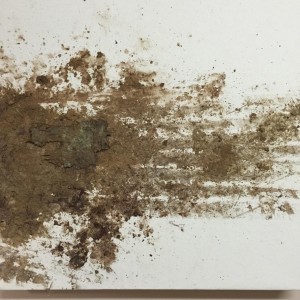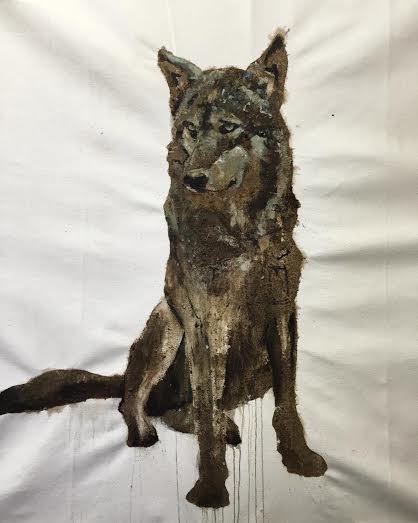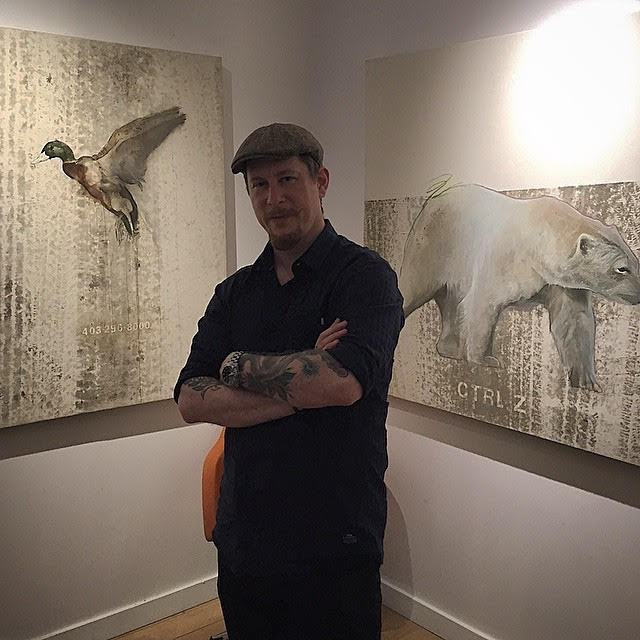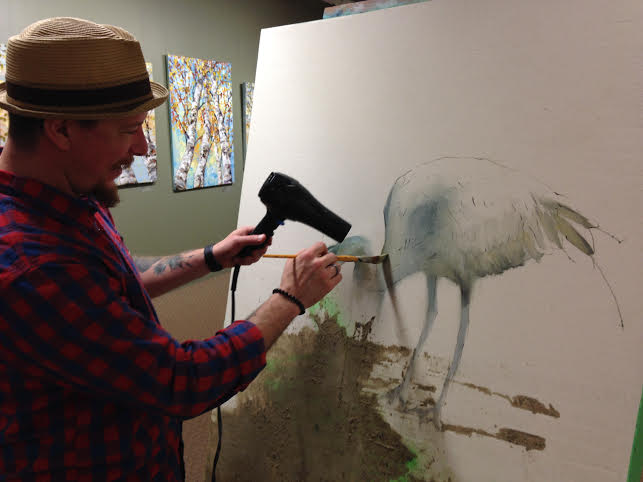Golden Encore Residency: The Follow-up
You’ll remember that in October, we partnered with Algonquin Provincial Park in hosting Daniel St-Amant for the Golden Encore Artist’s Residency. Since then he’s been working hard on the projects he began there.
We asked Daniel to talk about the experience and update us on his progress. Here’s a look at the amazing work he came up with and his thoughts on his time in the park…
When I was growing up I was raised in the country. I spent as much time as I could in the woods, wandering, exploring, playing, and imagining what it would be like to live in another time, one where survival depended on the way of the land. So naturally when I was approached by Algonquin and the Art Centre with the idea of doing an artistic residency in the park, I jumped at the opportunity.
My plan was to bring as much paint and canvas as possible so that I could maximize my week, to use this precious time allotted to me to catch up on commissions and projects I haven’t been able to work on… basically just become a painting factory. I thought this because my day to day reality is pretty hectic. I live in the city and have a career as a VFX and digital painter. Usually, I can only spend weekends and evenings in my painting studio. On top of all that, I am also a husband and father of 2 beautiful children. As you can imagine, my life is busy, but busy in a fantastic way. So getting a week alone in the woods with no work or any distractions meant I could paint like a hurricane until I unpacked and sat at the little picnic table that was outside my cabin overlooking the lake.
I had this whole thing planned out. It was going to be extremely productive, except the moment I arrived I forgot about all my plans, I forgot about my schedule, I forgot about my timelines and deadlines. I honestly was so at peace with my surroundings. And that’s when my sense of exploration took over, something I hadn’t felt since my childhood. I began by walking in the woods every day, first thing after my cup of coffee. I would walk and collect specimens like a mad scientist, anything that peaked my interest in terms of colour or texture. At that time of year, you can just imagine how alive the woods are with colours, as if you’re walking through a Tom Thomson painting. This, to me, was heaven. I probably collected ten buckets full of leaves and branches and moss, basically anything that I felt I had to have. I gathered my thoughts and came up with a plan of making collage paintings using dirt and objects that I picked up on the way. I sectioned off the cabin. One room was designated for drying out my samples, which I spread out on the floor and flattened under books, and another room was for painting and drawing. I even had a room that I used for my wood shop to make stretchers. It was fantastic. I began experimenting with different media that I could use in addition to my current practice.
 a canvas prepared with local materials
a canvas prepared with local materials
My typical work uses dirt and grime collected from the busy city streets. As my canvass are spread over the roadways cars run over them leaving their markings. This is a metaphor that represents humanity’s technologies that are causing harm to the environment. Typically I create backdrops made out of these markings, which I use to house the animal portraits I paint. This work is a direct response to city living. I see squirrels and raccoons running around, trying to avoid humans, all the while trying to survive in an urban setting. Being in the woods, I was away from it. Nature seemed more comfortable. Birds chirped with enthusiasm. Little woodland creatures scampered around happy. I felt that my work would change dramatically if I spent a prolonged time at the lake. My vision of my animal portraits changed into more of an evolutionary standpoint, I pictured animals growing out of my samples of sticks, leaves and bark. Instead of creating a portrait of an animal living within the confines of my tire tracks or “a human presence,” I wanted them to bloom out of the bottom of the canvas like a flower or a tree. It was a real eye opener, how one environment could change my visual reactions and my concision.
The 6 days flew by in retrospect, but while I was there, time was much slower. I spent a few days at the Visitor Centre doing a demonstration and one day at the beautiful gallery at Km 20. Some of my most memorable experiences were the people that I encountered and who helped organize the experience. I would like to especially thank Andrea Coulter and the owners of the Art Gallery, Joel Irwin and Matt Coles. Everyone was so accommodating and friendly I will never forget that short week I spent in my little cabin by the lake.
So now that I sit in my studio a few months after my time in Algonquin, my work has taken a bit of a right turn. No longer am I concerned with a negative outlook on the environment, hoping to spark a reaction out of the viewer. Now I am more interested in creating work that is a celebratory vision of nature. I now want the viewer to experience a positive reaction to my work. I want the viewer to look at my compositions and think about how beautiful nature is, how resilient it is. As an artist, you are always growing and moving in new directions.
I am extremely excited to see what’s to come.
 another of Daniel’s residency-pieces in progress
another of Daniel’s residency-pieces in progress
We’re so grateful that we can be part of giving artists the opportunity to pursue their craft and communicate their love of creation with Algonquin visitors. We’re committed to continuing these residencies. In fact, our spring residency, Perennial Threshold, has an application open to everyone, so if you want the chance to create… apply!
For now, we want to express our thanks to Algonquin Provincial Park and to Daniel himself for making this an amazing experience for everyone involved.





